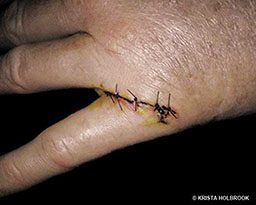I was freediving off Mexico’s Baja peninsula, and the marine life was incredible. So far it had been a fabulous vacation. My husband, Sterling, had thoroughly researched Palapas Ventana, where we were staying, and decided it was just what we were looking for. It’s located in the village of La Ventana, less than an hour’s drive from La Paz and a couple of hours from Cabo San Lucas. With a casual atmosphere and friendly inhabitants, sleepy little La Ventana was a world away.
It was our second day diving, and we were off the east coast of Cerralvo Island scouting for pelagic fish. Sterling and I had recently taken an intermediate-level Performance Freediving International course and were eager to use our improved skills.
My main interest these days is spearfishing. We chose Palapas because it offers world-class spearfishing with a bonus: Any fish that are not eaten or taken home are donated for sale with the proceeds benefiting the local school system. Previous improvements included a new soccer field, sporting equipment, and maintenance and renovations to the buildings.
Sterling and I had been taking turns dropping on a pinnacle, looking for amberjack. We were getting into the flow, comfortably making repetitive breath-hold dives to 60 or 70 feet. We had not encountered any pelagics yet, but we had seen some nice fish. It was mid-morning, and with the entire day ahead we were not in any hurry to shoot our limit.
Mexico has what I consider reasonable and generous fishing regulations. Visitors can each harvest five fish per day. Where I usually fish, in the southeastern U.S., it feels like you need a degree in marine biology to adhere to the ever-changing and increasingly complicated regulations. So far, I loved everything about diving in Mexico.
We made a quick stop to check for fish on a fish attractant device (FAD). An FAD is an ingenious and, in this case, handmade contraption that attests to the resourcefulness of the fishing community. This one consisted of a large bundle of tree fronds attached with a rope to concrete blocks located far below. FADs are very effective at attracting small bait fish and, thus, the larger pelagic fish that feed on them.
We were departing the FAD, and Sterling was aboard the panga (boat) with our captain when I got hurt. I was shooting a new Riffe Euro 120 speargun, having recently upgraded from my old Sea Hornet. The new Riffe was significantly more difficult for me to load due to its strong new bands. I had been unloading by simply shooting the gun, but this causes more wear on the equipment and increases reload time by requiring retrieval of the shooting line and replacement of the shaft.

I made two mistakes that contributed to the accident. The first was a lack of attentiveness as I unloaded my speargun, and the second was wearing an inexpensive pair of gardening gloves. Rather than simply shooting to unload, I elected to reverse the loading process; with the gun butt braced on my hip, I grabbed the base of the band to remove it from the tab on the spear shaft. Rather than paying close attention to what I was doing, I got distracted and glanced up at the boat. Before I could ease the band forward to release the tension, the butt of the gun slipped from my hip and shot forcefully backward.
Had I been wearing a good pair of diving gloves, this might not have caused an injury. Unfortunately, the cheap gardening gloves had rubber-coated palms, which offered a good grip and manual dexterity, but the backs of the gloves consisted of loosely woven fabric. As the gun shot backward, the safety hung in my left glove and cut a deep groove across the top of my hand.
It hurt quite badly, and I hoped it wasn’t too serious. Once on board I could see blood dripping from my glove, and I had to admit I was injured. Removal of the glove revealed torn skin and exposed tendons from the webbing of my little finger across the top of its first joint. We cleaned it with fresh water, and the captain applied a bandage and gave me an ice pack. He then radioed Tim Hatler, who, along with his family, owns and manages the resort.
It was about a 30-minute ride back to Palapas, where Tim’s wife, Jimena, was waiting to take me to the nearby emergency clinic. Fortunately, there was a skilled physician immediately available to care for my wound. He spent considerable time cleansing and inspecting the cut. There was some concern about tendon damage, and he conducted several tests to make certain my hand was functioning properly before he stitched it up.
Tim contacted DAN® immediately after he received the radio call, and they were prepared to arrange emergency transportation to a larger facility if the doctor felt it was necessary. As luck would have it, the wound did not require anything beyond cleaning and stitching. The doctor did a fantastic job sewing together the ragged edges of skin and gave me antibiotics and pain medication.
The stitches stayed in for several weeks and were removed by my personal physician the week after I returned home. DAN promptly reimbursed me for all related medical expenses — those incurred in Mexico as well as those incurred in the U.S.
The peace of mind that came from knowing I had dependable DAN medical insurance to cover the injury — no matter how severe it might be — was worth far more than the financial reimbursement. It totally alleviated my stress and worry about receiving adequate care. I’m happy to know DAN is there for me regardless of whether I’m diving close to home or somewhere far away.
© Alert Diver — Q3 Summer 2013